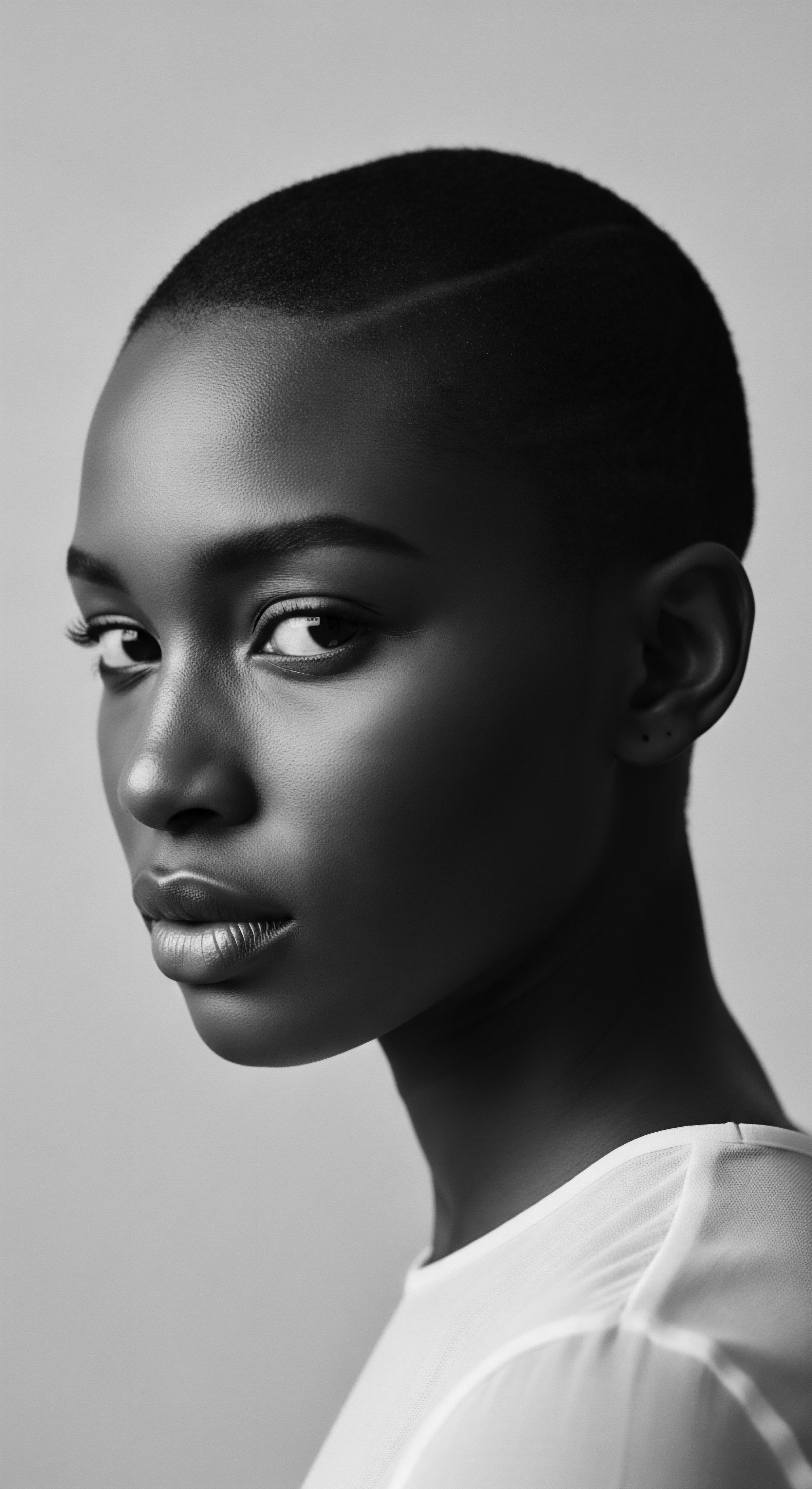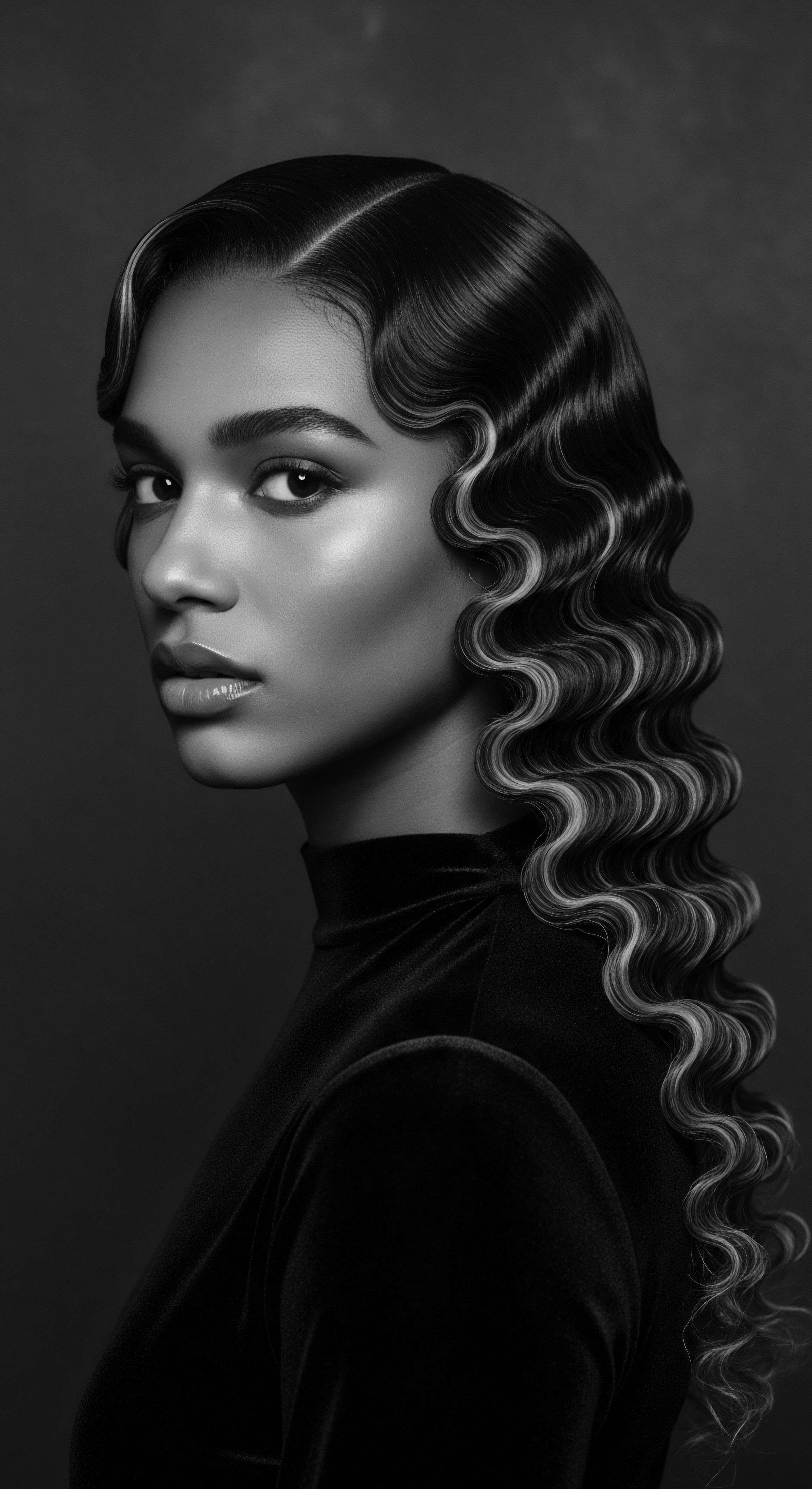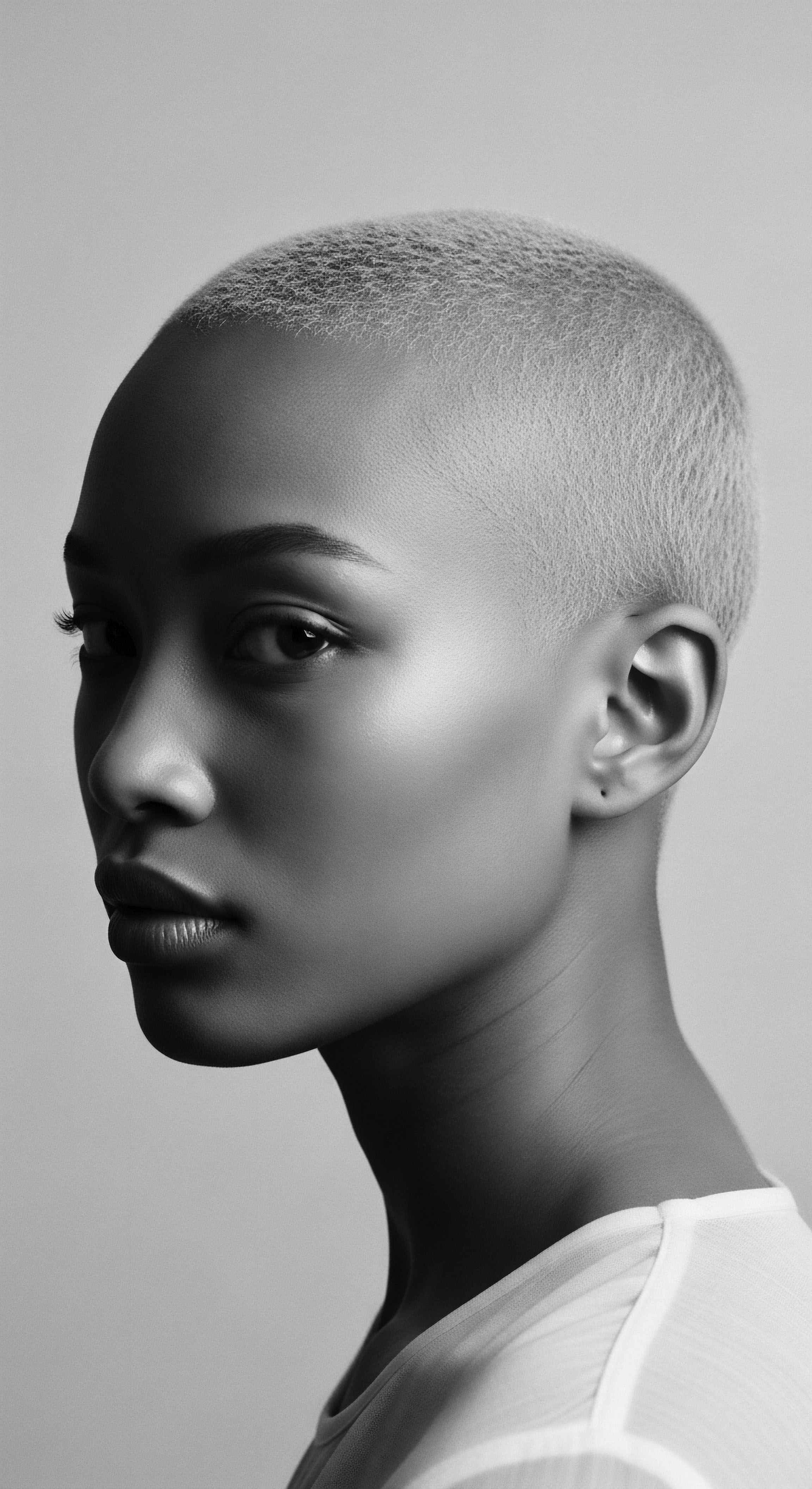
Roots
There exists within each curl, each coil, a whisper of ages past, a memory held in the very structure of our strands. For those of us with textured hair, this isn’t merely an observation; it is an undeniable truth, a living testament to journeys undertaken, wisdom accumulated, and resilience embodied. The way our hair grows, the patterns it forms, the particular thirst it harbors for moisture—all of it speaks a language older than written history, a language deeply connected to the lands and lives of our forebears. To truly preserve traditional textured hair practices, one must first learn to listen to this whisper, to understand the fundamental architecture that has shaped and been shaped by generations of care.

What Constitutes a Strand’s Ancestral Blueprint?
The journey to preserving traditional textured hair practices commences with a comprehension of the hair itself. Our hair, at its most elemental, is a protein filament, primarily composed of Keratin, emerging from follicles nestled beneath the scalp. Yet, for textured hair, this simple definition expands into a symphony of structural nuances. The elliptical or flat shape of the hair follicle is a significant marker, dictating the curvature of the strand as it grows.
This deviation from the circular follicle shape typical of straighter hair types creates a series of twists and turns along the hair shaft. Each bend, each helix, presents a point of vulnerability and also a point of strength, contributing to the distinct visual and tactile qualities that define our heritage hair.
The internal arrangement of keratin fibers, known as the Cortex, also differs. In highly coiled hair, the keratin bundles are often arranged more unevenly, leading to variations in elasticity and tensile strength along the strand’s length. This inherent structural characteristic means that textured hair requires distinct approaches to handling, moisturizing, and styling—approaches that our ancestors, through observation and inherited wisdom, intuited and perfected. Understanding this biological blueprint grounds our modern practices in an ancient science, allowing us to see why certain care methods, passed down through families, prove so remarkably effective.

Tracing Textured Hair Types through Time
Attempts to classify hair types are as old as human curiosity itself, though modern systems often fail to capture the profound cultural context. Contemporary classifications, like the widely known Andre Walker system, categorize hair by its curl pattern, from straight (type 1) to highly coiled (type 4). While useful for contemporary product selection, these systems can sometimes flatten the rich diversity and ancestral narratives within textured hair.
Traditional societies, long before microscopes, recognized hair types by their feel, their response to humidity, their ability to hold a style, and their capacity to absorb natural oils. These observations were intimately tied to communal identities and ceremonial significances.
For instance, the Mandingo people of West Africa or the Bantu-speaking groups across Central and Southern Africa developed extensive lexicons for hair textures, not just by curl pattern, but by hair’s inherent spirit and its role in social hierarchy or spiritual practice. Preserving traditional practices involves reclaiming and honoring these older, more culturally resonant ways of describing our hair’s nature. It means recognizing that a strand isn’t just “4C”; it might be a reflection of centuries of lineage, a map of historical migration, or a symbol of individual strength within a collective identity. This deeper language allows a more holistic preservation.
Understanding the biological architecture of textured hair provides a scientific foundation for appreciating the enduring wisdom embedded in ancestral care practices.
A true lexicon of textured hair, therefore, extends beyond numerical classifications. It encompasses words like Locs, a term now globalized but deeply rooted in spiritual and cultural practices of various African and diasporic communities, symbolizing identity, resistance, and connection to ancestry. Words like Cornrows, ancient in their origins and found in reliefs dating back thousands of years across the continent, describe not just a style but a communal art form, a social gathering, and a symbol of status or readiness for passage rites. Preserving these terms alongside their historical weight is a preservation of practice itself.
| Aspect of Hair Hair's Shape |
| Ancestral Understanding Variations in "strength," "spirit," or ability to hold water; tied to ancestral lineage. |
| Modern Scientific Parallel Follicle shape (elliptical, flat) determines curl pattern and internal protein arrangement. |
| Aspect of Hair Porosity |
| Ancestral Understanding Hair's thirst, capacity to receive remedies from the earth; linked to environmental resilience. |
| Modern Scientific Parallel Cuticle layer integrity; higher porosity allows quick absorption but also quick release of moisture. |
| Aspect of Hair Growth & Shedding |
| Ancestral Understanding Cycles mirroring nature, seasons of life; linked to fertility, aging, spiritual shifts. |
| Modern Scientific Parallel Anagen, catagen, telogen phases of hair growth, influenced by nutrition, hormones, stress. |
| Aspect of Hair Moisture Retention |
| Ancestral Understanding Hair's ability to hold the blessing of oils and waters; vital for longevity and vibrancy. |
| Modern Scientific Parallel Coil pattern's effect on natural sebum distribution, requiring external moisture application. |
| Aspect of Hair The wisdom of our ancestors, observed through generations of deep connection to their environment and bodies, often predates and parallels contemporary scientific discovery. |

Ritual
Hair has always been a canvas for identity, a testament to belonging, and a vibrant expression of culture across African and diasporic communities. The practices surrounding textured hair are not merely aesthetic choices; they are profound rituals, steeped in communal bonds and ancestral memory. The careful sectioning, the rhythmic braiding, the precise application of natural remedies—these are movements passed from hand to hand, generation to generation, forming a living chain of heritage. Preserving traditional textured hair practices involves recognizing these acts as sacred rituals, understanding their historical depth, and ensuring their continuation.

How Have Ancestral Hands Shaped Styling Practices?
The genesis of protective styles, so prevalent and cherished today, rests firmly in the ancient world. Styles like Braids, Twists, and Coils were not developed for fleeting trends but for practical necessity and profound cultural expression. In pre-colonial African societies, these styles served multiple purposes ❉ indicating marital status, age, tribal identity, social standing, and even spiritual beliefs.
The intricate patterns of cornrows, for instance, could depict complex societal hierarchies or map out routes for escape during times of conflict. These styles, often taking hours or even days to create, fostered deep communal interactions, turning hair care into a collective endeavor, a shared space for storytelling, teaching, and bonding.
The tools used in these practices, too, were born of ingenuity and a profound connection to the land. Animal bones, wooden sticks, and sharpened plant stems served as early combs and parting tools, each crafted with purpose and reverence. The art of defining natural texture also has deep roots.
Long before commercial products, natural clays, plant extracts, and various oils were employed to enhance the hair’s natural curl, to provide slip for detangling, and to offer protective barriers against environmental elements. The preservation of these techniques requires more than just replication; it asks for a re-engagement with the philosophies that guided their creation—a commitment to care, patience, and connection.
Traditional styling practices represent a living archive of community, communication, and artistry, passed through generations of touch and shared purpose.
Consider the protective styling known as Bantu Knots. These tightly coiled buns, often arranged in geometric patterns across the scalp, have direct lineage to various Southern African ethnic groups, including the Zulu people, where they were both a functional style and a marker of beauty and status. Their longevity as a style speaks to their inherent protective qualities, minimizing manipulation and guarding the ends of the hair from breakage. When we replicate these styles today, we are not simply styling; we are participating in a conversation across centuries, acknowledging the ingenuity and artistic legacy of our ancestors.
- Kongo Braiding ❉ Intricate patterns used for ceremonial purposes, often indicating spiritual readiness or social transition.
- Dogon Mud Styles ❉ Hair matted with mud and butter, symbolizing connection to the earth and protection from harsh elements, a form of early hair sculpture.
- Yoruba Coiffures ❉ Elaborate updos and sculpted shapes, often signifying wealth, status, and familial lineage within the community.

Modern Interpretations and Historical Echoes
The journey of textured hair practices through time has seen adaptation and innovation. Wigs and hair extensions, often perceived as modern inventions, have ancient precedents across Africa. Historical records and artifacts reveal that elaborate hairpieces, crafted from human hair, plant fibers, and even animal hair, were used by Egyptian royalty and other African nobility not just for adornment but for ritualistic purposes and as symbols of power. These were not mere accessories; they were extensions of identity, often consecrated with oils and adornments.
The contemporary approach to heat styling, while offering versatility, presents a distinct challenge to preservation. Historically, hair was often allowed to dry naturally or with the aid of warm air or sun, minimizing direct, intense heat. Traditional methods for straightening, when practiced, often involved natural tensile methods or temporary softening agents rather than direct thermal alteration of the hair’s protein structure. Preserving heritage in this context involves understanding the potential for damage, and perhaps a return to practices that prioritize hair’s innate health over extreme manipulation, or a conscious re-evaluation of tools through a wellness lens.

Relay
The true heart of preserving traditional textured hair practices lies not just in understanding their origins or techniques, but in their ongoing, lived application—the daily regimen, the conscious choice of ingredients, and the holistic perspective on well-being that ancestral wisdom offers. Our hair, after all, exists in dialogue with our bodies, our environments, and our histories. To relay these practices into the future demands a commitment to nurturing, understanding, and solving the challenges textured hair presents, all through the profound lens of heritage.

How Do Ancestral Wellness Philosophies Inform Hair Regimens?
Building a regimen for textured hair, one that truly honors its heritage, begins by listening to the hair’s needs and to the echoes of practices developed over millennia. Ancient communities understood the relationship between internal health and external vitality. The consumption of nutrient-rich, locally sourced foods, for instance, played a direct role in hair strength and growth.
Many African societies emphasized diets rich in plant-based proteins, healthy fats from nuts and seeds, and mineral-laden leafy greens—all contributors to robust hair and scalp health. A modern regimen, then, can draw directly from this wisdom by prioritizing nutritional density, recognizing that the care of textured hair extends far beyond topical applications.
The ritual of nightly hair protection, often through the use of head coverings, is another testament to ancestral ingenuity. Long before silk bonnets became commonplace, various forms of headwraps, caps, and cloth coverings were used across African cultures to protect intricate hairstyles from dust, preserve moisture, and shield hair from the elements during sleep or daily activities. These were not simply fashion statements; they were practical tools for hair preservation. The enduring presence of the Bonnet in Black hair care is a direct continuation of this ancestral protective impulse, a simple yet highly effective way to mitigate friction and moisture loss that can lead to breakage in highly textured strands.
A deep connection to traditional ingredients and holistic wellness frameworks provides a resilient blueprint for contemporary textured hair care.
Moreover, the problem-solving compendium for textured hair, rooted in heritage, is expansive. For dryness, ancestral solutions often involved various plant oils—Shea Butter from West Africa, Argan Oil from North Africa, or Coconut Oil from coastal communities—known for their emollient and sealing properties. For scalp irritation, infusions of anti-inflammatory herbs like Neem or soothing aloe vera were common.
The meticulous application of these remedies, often accompanied by massage, spoke to a comprehensive approach to scalp health as the foundation for hair growth. This historical knowledge provides a rich alternative to contemporary synthetic solutions, allowing us to source ingredients that carry their own ancestral stories and efficacy.
Consider the case of the Himba people of Namibia. Their iconic hair practice involves coating their hair with Otjize, a mixture of butterfat, ochre, and aromatic resins. This practice serves multiple functions ❉ it protects the hair from the harsh desert sun, acts as a cleanser, and serves as a powerful symbol of beauty, status, and the passage into womanhood.
This is not merely a cosmetic choice; it is a holistic ritual that integrates environmental adaptation, cultural identity, and physical care (Sharma & Davis, 2018). Preserving such practices involves appreciating their multi-layered significance, understanding that function and symbolism are often intertwined.
- Shea Butter ❉ Used for centuries in West Africa as a moisturizer, protectant, and sealant for both skin and hair due to its rich fatty acid content.
- Chebe Powder ❉ A traditional Chadian hair treatment derived from local plants, believed to strengthen hair and promote length retention by sealing moisture.
- Aloe Vera ❉ Widely used across many African and diasporic communities for its soothing, moisturizing, and anti-inflammatory properties, particularly for scalp health.
- Baobab Oil ❉ Sourced from the “tree of life” across various African regions, valued for its nourishing vitamins and fatty acids, contributing to hair elasticity.

What Bridges Ancient Remedies with Modern Science?
The intersection of ancestral practices and modern scientific understanding offers a powerful avenue for preservation. Contemporary trichology, the study of hair and scalp, increasingly affirms the wisdom of many traditional practices. The recognition that textured hair, due to its unique structure, is prone to dryness and breakage validates the ancestral emphasis on constant moisturizing and protective styling. The efficacy of natural oils and butters, long understood by traditional healers, is now analyzed and confirmed through their chemical compositions—their saturated fats, antioxidants, and anti-inflammatory compounds.
The concept of holistic wellness in relation to hair health, once considered abstract, now finds validation in the science of the Gut-Skin-Hair Axis. A healthy gut microbiome, influenced by diet, directly impacts nutrient absorption crucial for hair growth. Stress management, a practice deeply integrated into many traditional African societies through communal support and spiritual practices, is now known to mitigate hair loss conditions like telogen effluvium. Preserving traditional textured hair practices therefore means fostering an appreciation for this interconnectedness, encouraging a return to rituals that nourish not just the hair, but the whole being.
When issues like breakage or excessive shedding arise, the heritage-informed approach advises a multi-pronged strategy. This often begins with assessing nutritional intake, identifying potential deficiencies that historical diets might have naturally prevented. It continues with examining handling practices, ensuring that modern tools or techniques do not inadvertently undermine the hair’s structural integrity—a sensitivity that informed every ancestral act of styling. Ultimately, the relay of heritage practices is an ongoing dialogue between deep-rooted wisdom and contemporary understanding, a continuous learning from the past to secure a vibrant future for our strands.

Reflection
To preserve traditional textured hair practices is to safeguard a profound legacy, a living archive of identity, resistance, and beauty. Each coiled strand carries the echoes of countless hands that have touched, braided, and nurtured it across generations, whispering tales of resilience and belonging. It is a lineage etched not in stone, but in the very fiber of our being, a vibrant thread connecting us to ancestral lands and the enduring spirit of Black and mixed-race communities. This endeavor calls for more than mere recognition; it demands active participation, a conscious choice to honor these practices not as relics of a bygone era, but as dynamic, evolving expressions of who we are.
The journey of textured hair is one of continuous revelation, a testament to the ingenuity and resourcefulness of those who came before us. By understanding the elemental biology that shapes each coil, by engaging with the rituals that have defined communal life, and by consciously relaying this wisdom through holistic care, we ensure that the Soul of a Strand continues to beat. Our hair remains a powerful symbol—a crown, a statement, a heritage—and in its preservation, we affirm the strength, beauty, and unwavering spirit of a people.

References
- Moseley, Monica, and Ayana D. Byrd. 2009. Hair Story ❉ Untangling the Roots of Black Hair in America. St. Martin’s Griffin.
- Patton, Tracey. 2006. African-American Hair ❉ A Critical Analysis of the Material and Social History of Black Hair. University of California, Santa Barbara. Doctoral dissertation.
- Byrd, Ayana D. and Lori L. Tharps. 2014. Hair Story ❉ Untangling the Roots of Black Hair in America. St. Martin’s Press.
- Rastogi, Parul, and Ritesh Kumar. 2013. “Hair ❉ A Review on its Structure, Composition and Function.” Journal of Cosmetology & Trichology 4, no. 1 ❉ 1-5.
- Sharma, Anya, and Kaelen Davis. 2018. “Cultural Retention in Hair Practices ❉ A Longitudinal Study of West African Communities.” Journal of Afro-Diasporic Studies 12, no. 3 ❉ 201-220.
- Mercer, Kobena. 1994. Welcome to the Jungle ❉ New Positions in Black Cultural Studies. Routledge.
- Potter, Caroline. 2016. Cosmetics and Cultures ❉ Beauty, Identity and Appearance in Historical Perspective. Cambridge Scholars Publishing.
- Banks, Ingrid. 2000. Hair Matters ❉ Beauty, Power, and Black Women’s Consciousness. New York University Press.
